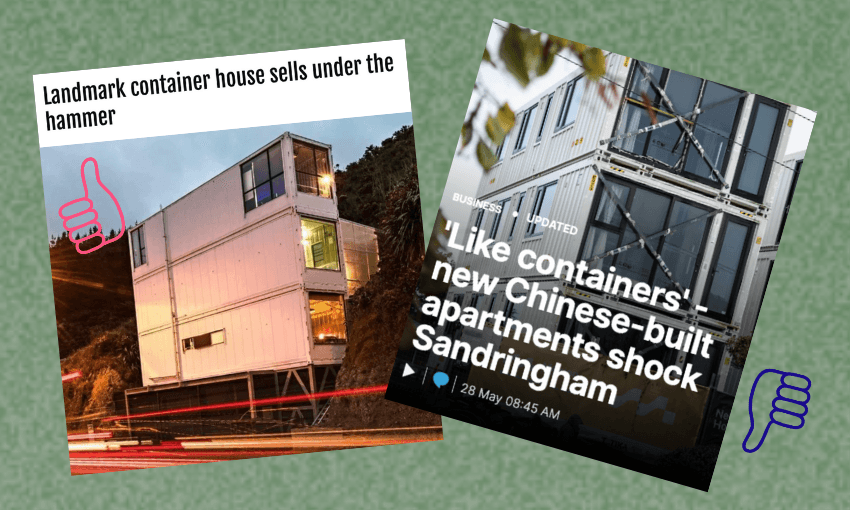Is the whole of Sandringham upset about some basic new apartments or is there another, bleaker reason for the story, asks Madeleine Chapman.
There are some things that are considered unacceptable when done by poor people and extremely cool and normal (or at least ignored) when done by rich people. Day drinking, getting money from the government, getting a reduced sentence after committing a crime, having other people raise your kids, driving an old car. And now we have a new one: building and living in homes that look like shipping containers.
“‘Like containers’: new Chinese-built apartments shock Sandringham” was the leading story on the Herald website this morning (and has now been republished by RNZ). Aside from the worrying dog-whistle that could easily be read as “apartments built by Chinese people”, there’s much to unpack here. The apartments, which Kāinga Ora commissioned through prefabricated housing business Ecotech, were shipped from China in their preliminary form, and will be assembled and completed in Sandringham, where interiors, decking and facades will be added. The exteriors are container-like (though Ecotech insists they are not container houses), which seems to have upset some residents.
No one quoted in the article mentioned the country of origin of the units, nor had any issue beyond the appearance of the unfinished apartments. So why put “Chinese-built” in the headline? I presume any future article mentioning a Toyota will be headlined “Japanese-built vehicle”. But we all know the connotations behind “Chinese-built” so putting it in a headline where people are complaining is beautiful clickbait. The article quotes residents decrying the new development, the first being “We’re starting to look like ghetto cities that we see in other countries.”
Turns out the entire article is based on a post in the Sandringham community Facebook page, where there was an even split between those who didn’t like the look and those who were happy to see new housing in the area. I await the news article based on the posts of my local community page – “‘Shocking’: residents appalled by brown woman walking past security camera”.
As for the apartments themselves, this is not the first time the container style has been called into question. “Kāinga Ora’s ‘container’-like Rotorua homes at Malfroy and Ranolf shock residents” is a headline from April about a similar Rotorua development. Again, the apartments were unfinished and again Kāinga Ora insisted they were simply a different style of home.
These sorts of complaints and accompanying news articles seem to come from those who’d prefer that no more homes were built, or if they had to be built then every new home should be a weatherboard villa, and if there had to be apartments, they could be three weatherboard villas stacked on top of each other.
What’s so bad about homes that look like storage containers? Nothing. In fact, not long ago and in a different demographic, they were incredibly sought after. In 2020, a four-container home (that is actually four containers) sparked a bidding war at auction in Wellington. The home was built over many years and was reported to have been an incredibly popular AirBnB rental before it sold. The article on the auction did not quote any shocked residents or note the origin of the storage containers, though it’s safe to assume they too were built in China since 85% of all containers in the world are manufactured there.
In Auckland’s Mount Albert (just one suburb over from the new Sandringham shipping yard), Ockham Residential’s Modal building had hundreds of open day viewing slots booked out in advance, with huge demand for the carless rental apartments. I love the Modal building but it really is just a big black slab, certainly not in line with the rest of Mt Albert’s homes.
So why are container homes so bad all of a sudden? Well, now they’re Kāinga Ora homes for those in need of social housing. This style of living is no longer the hallmark of friendly middle-class earners choosing to live in two containers stacked on top of each other and calling it a tiny home. These new Sandringham residents might be loud and/or poor and live in something that looks like a storage container. Ghetto, indeed. Oh and they’re “Chinese-built” too which is important to mention and presumably bad, but don’t think too much about that part.



